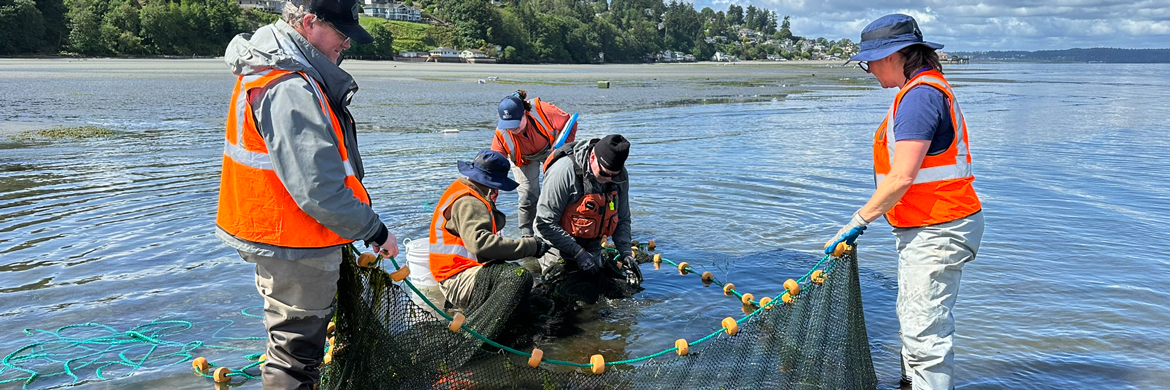Long-term aquatic monitoring programs

In 2014, the King County Council appropriated funding to the King County Department of Natural Resources and Parks, Water and Land Resources Division (WLRD) for monitoring contaminants in fish and shellfish from King County’s major aquatic environments. As a result, we developed two long-term monitoring programs that track the presence and concentrations of contaminants and chemical biomarkers in fish and shellfish from King County’s fresh and marine waters.
We collect data every year to understand how levels of these contaminants are changing over time in the organisms we track across the regions we monitor. This long-term data is vital to assessing the health of our aquatic resources. We collect data from common fishing and crab harvesting locations and target species typically eaten by people in King County. We share our program data with partners, decision makers, and local fishers to support their efforts at reducing pollution and its ecological and human health impacts.
To see how we work with local communities to adjust and expand our long-term monitoring program, check out our recent pilot fish survey project with the Refugee Federation Service Center.
Marine monitoring
Our long-term marine monitoring program has been collecting data on contaminants in fish and shellfish since 2014. We collect seafood species from Elliott Bay and various other Puget Sound locations within King County. The King County Environmental Laboratory analyzes tissue samples from the collected organisms for a suite of toxic contaminants including polychlorinated biphenyls (PCBs), per-and polyfluoroalkyl substances (PFAS), polybrominated diphenyl ethers (PBDEs), metals (including mercury), and chlorinated pesticides (e.g., DDT). Many of these contaminants can bioaccumulate in fish and shellfish tissues over time, posing risks to people and other organisms that eat seafood.
To learn more about our long-term marine monitoring program, visit our Fish and Crab Toxics Monitoring page.
Freshwater Monitoring
The long-term freshwater fish monitoring program has been collecting data from King County lakes and rivers since 2014. These waterbodies include Lake Washington, Lake Union, Lake Sammamish, the Cedar River, and the Green River. Samples are collected on a rotating schedule which results in each waterbody being sampled every five (5) years. We collect various fish in these lakes and rivers, focusing on those commonly eaten by recreational, subsistence, and tribal fisher-people.
Fish in King County lakes and rivers are exposed to various contaminant sources (stormwater runoff, combined sewer overflows, industrial inputs, etc.), which impact the aquatic ecosystem and may end up harming human health. Fish exposure to bioaccumulative contaminants like polychlorinated biphenyls (PCBs), PFAS, and mercury has led to Washington State Department of Health (DOH) fish advisories in several water bodies across King County, including Lake Washington, Lake Sammamish, Green Lake, Lake Meridian, and the Lower Duwamish River. These current DOH fish consumption advisories are known examples of existing human health risks from chemical bioaccumulation in fish.
The freshwater long-term monitoring program helps assess the risks of eating fish in King County waterbodies as well as the health of our aquatic ecosystems and species.

 Translate
Translate